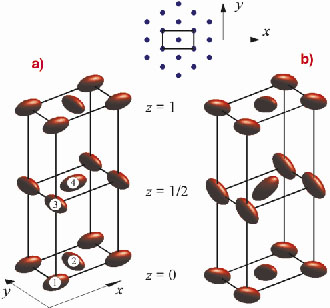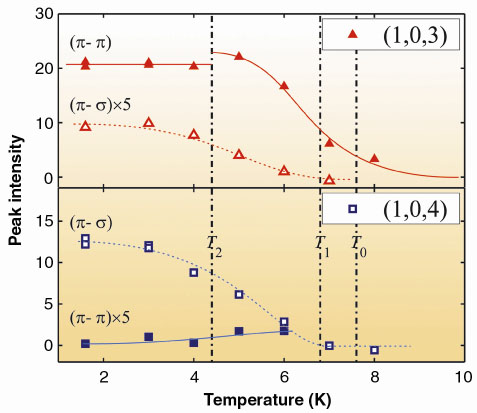- Home
- Users & Science
- Scientific Documentation
- ESRF Highlights
- ESRF Highlights 2001
- Magnetism and Electronic Properties of Solid
- Quadrupolar Order of the 5f Electrons in UPd3 Studied with Resonant X-ray Scattering
Quadrupolar Order of the 5f Electrons in UPd3 Studied with Resonant X-ray Scattering
The electron-shell specificity of X-ray resonant scattering (XRS) is now widely used to investigate a diversity of ordering phenomena in solids. Examples include magnetic, orbital and more recently quadrupolar order. Restrictions imposed by accessible absorption edges often mean that it is difficult to probe the electron states responsible for the order. Using XRS at the U MIV edge (3d3/2 5f5/2), we have studied directly the anti-ferroquadrupolar (AFQ) order of the 5f electrons in UPd3.
From earlier studies of bulk properties and neutron scattering it had been established that below T0 ( ~7.6 K) UPd3 undergoes a sequence of transitions between different AFQ structures (Figure 99). Neutron diffraction, which is not directly sensitive to the AFQ order, but does measure any accompanying lattice distortions, showed the existence of two distinct ordering wavevectors, q = (1,0,l), with l even or odd (orthorhombic notation).
 |
Fig. 99: Proposed AFQ structures in UPd3. (a) The U 5f quadrupole moments on the quasi-cubic sites of the dhcp unit cell are represented as ellipsoids. Within one basal (x-y) plane there is a doubling of the unit cell along x. For the phase between T1 < T < T0 there is an anti- phase stacking of quadrupole moments along z. (b) Possible structure of the AFQ phase below T1. |
Our XRS experiments were performed on ID20. At base temperature (T = 1.6 K), superlattice peaks were observed at (1,0,3) and (1,0,4). Both peaks displayed resonant behaviour close to the dipolar transition energy (3.728 keV) at the MIV edge of U, confirming that the peaks originate from ordering of the 5f electrons. At resonance, the polarisation properties of each peak were then determined as a function of temperature, and the results are summarised in Figure 100. Particularly noticeable is the existence of strong critical scattering at (1,0,3) for T > T0.
 |
Fig. 100: Temperature dependence of the (a) (1,0,3) and (b) (1,0,4) superlattice peaks measured with a polarisation analyser at the MIV edge of U. For each peak the unrotated ( |
For the phase between T1 < T < T0, the (1,0,3) reflection appears in the (-
) channel at resonance. Detailed calculations of the cross-section show that this is consistent with the AFQ structure shown in Figure 99a. Below T1 the (1,0,4) reflection appears mainly in the (
-
) channel, and a weak (
-
) component also develops at (1,0,3). This indicates that below T1 the ellipsoids must distort away from the high-symmetry directions. A structure consistent with our observations is shown in Figure 99b.
In conclusion, our XRS experiments give direct evidence for AFQ ordering of the 5f electrons in UPd3, and provide new insight into the nature of the phase transitions in this fascinating compound.
Principal Publication and Authors
D.F. McMorrow (a), K.A. McEwen (b), U. Steigenberger (c), H.M. Rønnow (a) and F. Yakhou (d), Phys. Rev. Lett. 87, 057201 (2001).
(a) Risø National Laboratory (Denmark)
(b) University College London (UK)
(c) ISIS Facility (UK)
(d) ESRF



